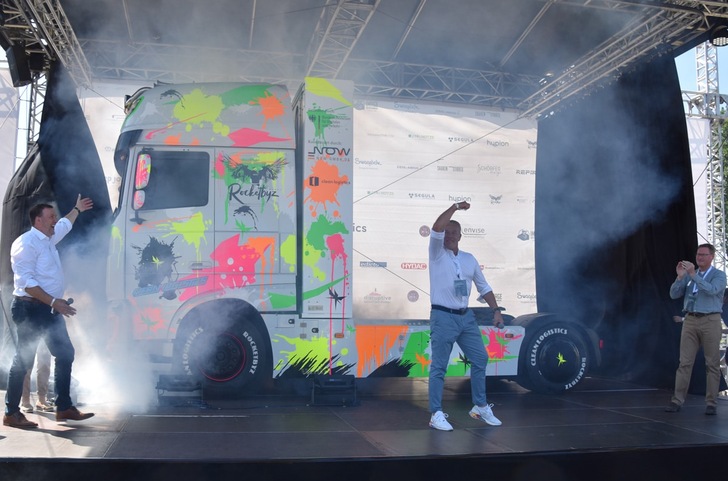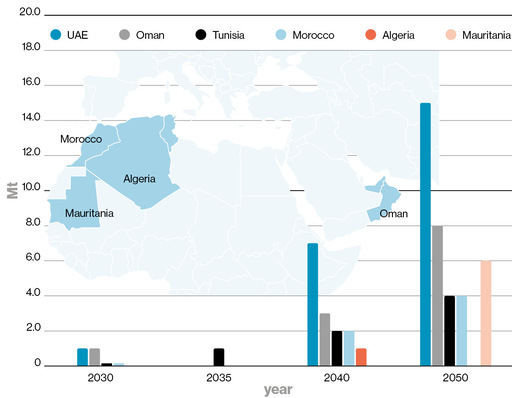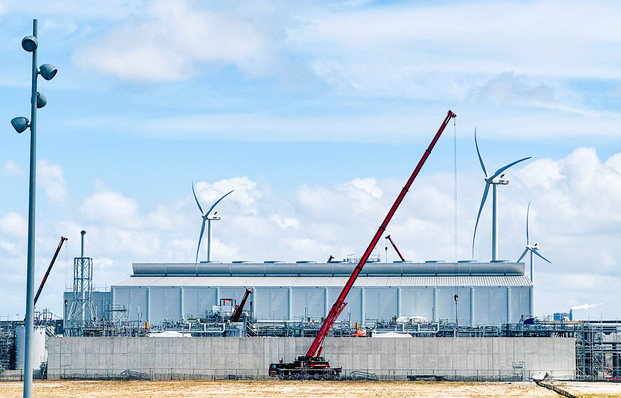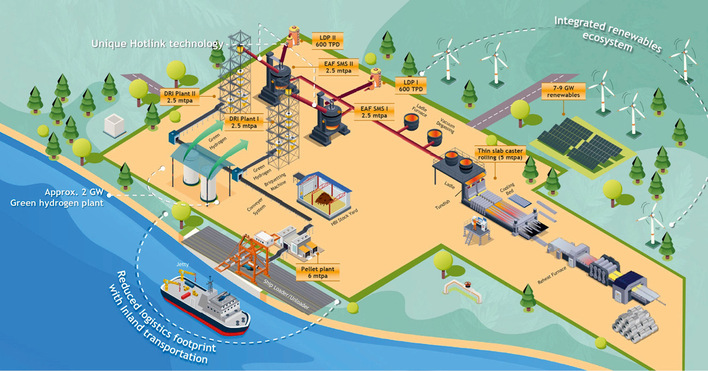The presentations of new hydrogen trucks are becoming more and more spectacular. After first Faun in Bremen and then Paul Nutzfahrzeuge in Vilshofen each introduced their new H2 trucks the June of 2022, Clean Logistics (CL) followed suit on June 23rd. Paul Nutzfahrzeuge, in a hybrid in-person/online event with much dramatic steam and music, ushered in the PH2P. Clean Logistics topped this and held races with its new fyuriant on the grounds of the local airport in front of 600 invited guests.
The interest was great – on the industry side with shipping and logistics specialists as well as on the investor side, along with the media. Everyone wanted to watch and see how the retrofitted H2 truck (tractor unit) from Clean Logistics would fare against its diesel counterpart. Long story short: In the drag race – narrated by Formula 1 commentator Kai Ebel – Swedish technology influencer Angelica Larsson, in the fyuriant, gave opponent Janina Martig, in the diesel truck, no chance.
From HyBat-Truck to fyuriant
In the midsummer heat, the two Clean Logistics founders Dirk Lehmann and Dirk Graszt, affectionately referred to as H2D2, revealed a colorfully painted hydrogen-powered tractor unit. At their side was Dr. Klaus Bonhoff from the federal transport ministry (BMVD), formerly head of the national administrative organization for hydrogen and fuel cells (Nationale Organisation Wasserstoff- und Brennstoffzellen-Technologie, NOW). Both institutions, BMVD and NOW, have been giving support to the small business founded in the state of Niedersachsen since 2017 and thus had a large part in the bringing about of this spectacle.
Bonhoff frankly explained that we “have achieved relatively little so far in the vehicle sector.” But then he pointed out that the now presented H2 truck that came out of the NIP program HyBat-Truck was excellent and that its development had been supported with 3.3 million euros of government funding. The first talks about a truck were held with shipping specialist Dirk Graszt in 2017, and then Dirk Lehmann was brought in. Lehmann, who is actually a shipbuilder, was immediately enthusiastic about the idea of converting long-haul trucks to run on hydrogen. At the time, Lehmann was managing director of E-Cap Mobility GmbH, which electrifies, in addition to maritime vehicles, also road vehicles.
The two Dirks teamed up, and this resulted in CL. Since then, they have been working to convert conventional diesel vehicles to zero-emission H2 vehicles. After buses, the formerly small company from Niedersachsen will immediately also be pushing out 40-tonne semi-trucks for the program.
“The demand is enormous,” stated Graszt in Stade. It’s no surprise, since according to the German climate protection law (Klimaschutzgesetz, KSG), greenhouse gas emissions in the transport sector must fall to 48 percent of 2019 levels by 2030. This means that of the 340,000 trucks currently registered nationwide, around 240,000 will need to be operated climate-neutrally by then.
“We are starting with a big bang into a new era... We already have the capability to make zero-emission vehicles available on the market today. Thanks to the converting of classic diesel vehicles into emissions-free hydrogen vehicles, this is also being done in a very resource-saving way. This is how we will rapidly drive the transformation of mobility into a sustainable future.”
Dirk Graszt, CEO of Clean Logistics
New CI – new logo
During the premiere at the airport in Stade, Clean Logistics SE presented itself in a completely new design – with a new corporate identity. With a new logo and a much more internationally oriented strategy. Additionally, Lehmann said, “We’re integrating Chinese technology.” The reason for this is obvious: “They're six or seven years ahead of us in China... Refire does fully automated series production.” These compliments were likewise returned by Audrey Ma, vice president of Refire, who said, “Clean Logistics has made history by making clean logistics accessible to the world.”
Over-length is an issue
Clean Logistics sees itself purely as an integrator. The components are purchased and brought in – whether it’s the two 120 kW capacity fuel cells from Refire or the 43-kg hydrogen tanks stacked directly behind the driver’s cabin. Although these allow a range of over 400 km (250 mi), at the same time they make the vehicle around 60 centimeters (24 inches) longer.
The result of this “over-length” is that no series approval is possible under German law and only approvals on an individual basis have been granted up to now. Not only Clean Logistics is fighting this bureaucratic imposition. Because production capacities are meant to be massively expanded in Winsen an der Luhe. In the new production hall of 10,000 m2 effective area (110,000 ft2), up to 450 vehicles a year are to leave the yard starting end of 2023.
EU type approval
The German automotive office (Kraftfahrtbundesamt) gave the Eugenius brand of the Faun Group, which was introduced in the August 2022 issue of H2-international, EU type approval, which means their vehicles are allowed in road traffic throughout the EU without additional approvals from member states. Head of development Georg Sandkühler said, “As our type approval is the first granted worldwide for hydrogen-powered commercial vehicles, it means that this type of drive has taken a big step forward overall.” However, their trucks are also not over-length, because the H2 tanks are integrated in the chassis.
It was almost exactly one year ago that Clean Logistics gave the first pyuron, a hydrogen-converted bus, to the public transit company of the Uckermark in Brandenburg (Uckermärkische Verkehrsgesellschaft, UVG). The bus has been transporting tourists in the lower Oder River Valley ever since.
Fig. 2: At the celebration of the premiere, GP Joule had a special highlight to offer. André Steinau, managing director of GP Joule Hydrogen, announced to H2-international that its parent company has reserved 40 assembly stations for 40 fyuriants: “We will solve, with the production of H2, the building of H2 refueling stations and the offering of vehicles, the well-known chicken-and-egg problem.”
Dr. Klaus Bonhoff concluded, “No truck manufacturer can afford not to build H2 trucks.”
Paul Nutzfahrzeuge
Paul Nutzfahrzeuge GmbH is comparable yet quite different. Similarly to Clean Logistics, Paul is committed to H2 trucks. “Hydrogen will prevail,” sales manager Thomas Kotowski is certain. Up to 200 km (124 mi) – no matter the tonnage – battery-electric is indeed more efficient. But for longer ranges, only retrofit or fuel cell solutions come into question for him. Larger providers like Faun (see H2-international Aug. 2022) won’t be an issue, as the Bremen-based company with its Enginius brand caters to municipal vehicles on short and medium routes, whereas Paul targets mid-weight, so 12- to 16-tonne, trucks on distribution routes. Particularly package delivery services such as Hermes and DHL are potential partners here.
“Everything that Mercedes does not build with the assembly line, we build,” Kotowski told H2-international. As a special vehicles builder, the Vilshofen-based company concerns itself with not only old-time car restorations, but also installation of alternative drive systems. Paul started in 2016 with a facility that could build 1,300 vehicles a year. In order to meet the growing demand for custom-made products, a second site is currently being prepared, which is to double the total production capacity to 2,700 vehicles per year. An initial 22 units of purely H2-run trucks are foreseen for 2022, around 150 for 2023 and 500 per year for 2025. Each at an individual workstation, mind you. “We are crafters,” says Kotowski – not without pride.
Cooperation partner Shell is contributing the H2 refueling stations. There will probably be eight in 2023. Maximator stands ready as a technology provider. Although Shell is financially strong, 3 million euros for one H2 station with two pumps makes a big dent, even when the pressure is “only” 350 bar. And if several H2 trucks are to be filled, it could quickly amount to 1 tonne of hydrogen per day that needs to flow.
Paul is also involved in the service realm. “Anything that breaks, we replace,” states the key account manager. At the same time, he points out that only trained personnel may touch alternatively powered vehicles – in view of the shortage of skilled workers, for certain a bottleneck. In addition, a workshop conversion, at around 200,000 euros, will be costly.
Author: Sven Geitmann






